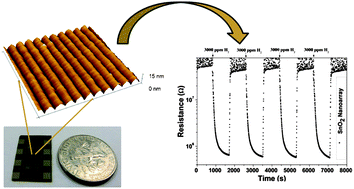Laser irradiated nano-architectured undoped tin oxide arrays: mechanism of ultrasensitive room temperature hydrogen sensing
Abstract
Undoped nanostructured tin oxide (SnO2) arrays were prepared on oxidized Si substrates by nanosecond pulsed laser interference irradiation for hydrogen gas sensing applications. Scanning electron microscopy (SEM), in combination with Atomic Force Microscopy (AFM), showed that the SnO2 surface consisted of periodic features of ∼130 nm width, ∼228 nm spacing, an average height of ∼8 nm along the periodicity and tens of microns length. The SnO2 nanostructured arrays and precursor thin films were tested by cyclic exposure under dynamic conditions of hydrogen in the concentration range of 300–9000 ppm. The observed electrical response of SnO2 towards hydrogen at low concentrations and room temperature drastically improved in the nanostructured array as compared to the thin film. The results suggest that this method to fabricate SnO2 nanostructured arrays has the potential to produce nanodevices that have ultra-low detection limits, and fast response and recovery times, which are suited for practical hydrogen sensing applications.


 Please wait while we load your content...
Please wait while we load your content...